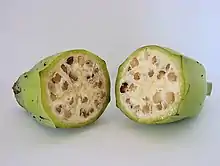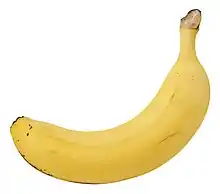Musa balbisiana
Musa balbisiana, also known simply as plantain, is a wild-type species of banana. It is one of the ancestors of modern cultivated bananas, along with Musa acuminata.
| Musa balbisiana | |
|---|---|
 | |
| Musa balbisiana fruit | |
 | |
| The fruit of M. balbisiana, showing numerous seeds | |
| Scientific classification | |
| Kingdom: | Plantae |
| Clade: | Tracheophytes |
| Clade: | Angiosperms |
| Clade: | Monocots |
| Clade: | Commelinids |
| Order: | Zingiberales |
| Family: | Musaceae |
| Genus: | Musa |
| Section: | Musa sect. Musa |
| Species: | M. balbisiana |
| Binomial name | |
| Musa balbisiana Colla 1820 | |
_original_range.png.webp) | |
| Original native ranges of the ancestors of modern edible bananas: M. acuminata is shown in green and M. balbisiana in orange.[2] | |
| Synonyms[3] | |
Description
It grows lush leaves in clumps with a more upright habit than most cultivated bananas. Flowers grow in inflorescences coloured red to maroon. The fruit are between blue and green. They are considered inedible because of the seeds they contain.
Taxonomy
It was first scientifically described in 1820 by the Italian botanist Luigi Aloysius Colla.[4]
Distribution
It is native to eastern South Asia, the eastern regions of the Indian subcontinent, northern Southeast Asia, and southern China. Introduced populations exist in the wild, far outside its native range.[5]
Uses
It is assumed that wild bananas were cooked and eaten, as farmers would not have developed the cultivated banana otherwise.[6] Seeded Musa balbisiana fruit are called butuhan ('with seeds') in the Philippines,[7] and kluai tani (กล้วยตานี) in Thailand,[8] where its leaves are used for packaging and crafts.[9] Natural parthenocarpic clones occur through polyploidy and produce edible bananas, examples of which are wild saba bananas.[10]
Genome
Musa balbisiana contributed the B genome to the cultivated banana.[11]
Wang et al., 2019 provides a genome, evolutionary analysis and functional genomics analysis.[11] Wang et al. find evolution increasing ethylene production in the domesticated form.[11]
See also
References
- Allen, R. (2019). "Musa balbisiana". IUCN Red List of Threatened Species. 2019: e.T111907032A111907034. doi:10.2305/IUCN.UK.2019-3.RLTS.T111907032A111907034.en. Retrieved 19 November 2021.
- Edmond de Langhe & Pierre de Maret (2004). "Tracking the banana: its significance in early agriculture". In Jon G. Hather (ed.). The Prehistory of Food: Appetites for Change. Routledge. p. 372. ISBN 978-0-203-20338-5.
- "Build checklist for Musa". World Checklist of Selected Plant Families. Royal Botanic Gardens, Kew. Retrieved 2013-01-22.
- "Musa paradisiaca". users.globalnet.co.uk.
- Perrier, Xavier; Langhe, Edmond De; Donohue, Mark; Lentfer, Carol; Vrydaghs, Luc; Bakry, Frédéric; Carreel, Françoise; Hippolyte, Isabelle; Horry, Jean-Pierre; Jenny, Christophe; Lebot, Vincent (2011-07-12). "Multidisciplinary perspectives on banana (Musa spp.) domestication". Proceedings of the National Academy of Sciences. 108 (28): 11311–11318. Bibcode:2011PNAS..10811311P. doi:10.1073/pnas.1102001108. PMC 3136277. PMID 21730145.
- Musa balbisiana Archived October 13, 2008, at the Wayback Machine
- "Progenitors of Edible Bananas". Guide to Growing Bananas. November 1, 2010. Archived from the original on July 7, 2011. Retrieved January 12, 2011.
- Plant use in Southern Thailand (PDF). Chiang Mai University. Archived from the original (PDF) on 2014-04-13.
- Karnjanatawe, Karnjana (19 August 2019). "Going bananas". Bangkok Post. Retrieved 19 August 2019.
- Michel H. Porcher; Prof. Snow Barlow (July 19, 2002). "Sorting Musa names". The University of Melbourne. Retrieved January 11, 2011.
-
- Van den houwe, Ines; Chase, Rachel; Sardos, Julie; Ruas, Max; Kempenaers, Els; Guignon, Valentin; Massart, Sebastien; Carpentier, Sebastien; Panis, Bart; Rouard, Mathieu; Roux, Nicolas (2020). "Safeguarding and using global banana diversity: a holistic approach". CABI Agriculture and Bioscience. 1 (1). doi:10.1186/s43170-020-00015-6. S2CID 257187109.
- This review cites this research.
- Wang, Zhuo; Miao, Hongxia; Liu, Juhua; Xu, Biyu; Yao, Xiaoming; Xu, Chunyan; Zhao, Shancen; Fang, Xiaodong; Jia, Caihong; Wang, Jingyi; Zhang, Jianbin; Li, Jingyang; Xu, Yi; Wang, Jiashui; Ma, Weihong; Wu, Zhangyan; Yu, Lili; Yang, Yulan; Liu, Chun; Guo, Yu; Sun, Silong; Baurens, Franc-Christophe; Martin, Guillaume; Salmon, Frederic; Garsmeur, Olivier; Yahiaoui, Nabila; Hervouet, Catherine; Rouard, Mathieu; Laboureau, Nathalie; Habas, Remy; Ricci, Sebastien; Peng, Ming; Guo, Anping; Xie, Jianghui; Li, Yin; Ding, Zehong; Yan, Yan; Tie, Weiwei; D’Hont, Angélique; Hu, Wei; Jin, Zhiqiang (2019). "Musa balbisiana genome reveals subgenome evolution and functional divergence". Nature Plants. 5 (8): 810–821. doi:10.1038/s41477-019-0452-6. PMC 6784884. PMID 31308504. S2CID 196814208.

